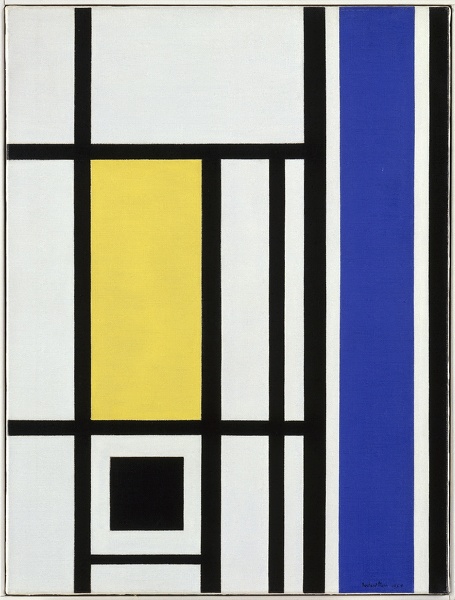
White, Black, Yellow and Blue, 1954
Framed (ref: 9974)
Oil on canvas
Signed and dated, 1954
27 ½ x 21 ½ in. (70 x 55 cm)
Tags: Marlow Moss oil Canney Abstract Art women Fifty Works by Fifty British Women Artists 1900 - 1950

Oil on canvas
Signed and dated, 1954
27 ½ x 21 ½ in. (70 x 55 cm)
Tags: Marlow Moss oil Canney Abstract Art women Fifty Works by Fifty British Women Artists 1900 - 1950
Provenance: Private Collection, UK
Preparatory works for this painting – with marginalia calculations – give an insight into Moss’s method and temperament. A design, once resolved on paper, was transferred to the canvas using precisely ruled pencil lines; the colours were laid down in turn – white last. A close examination of the painting’s surface indicates masking; the brush marks are consistently horizontal – even for the vertical forms. The rectangles are perfectly clean – butting up against each other like tiles.
This British artist has, in recent years, been ‘rediscovered’ with a touring Tate display (2013–2015) and a retrospective at Museum Haus Konstruktiv in Zürich (2017). Moss’s works, held in their respective collections, were on the walls at the Stedelijk, Amsterdam, and the Gemeentemuseum in the Hague as part of the 100 years of De Stijl celebrations across the Netherlands. She was up at Tate Britain for Queer British Art, and Virginia Woolf: An Exhibition Inspired by her Writings at Tate St Ives – a queer context and a feminist one respectively. Inclusion of Moss in the remit of Fifty Works by Fifty British Women Artists is potentially problematic (as is use of a feminine pronoun) in the fastdeveloping context of identity politics and transgender discourse.
Moss arrived in Paris from London in 1927, long-established in the persona and masculine dress of ‘Marlow’ but unformed as an artist; she was greatly moved by seeing the work of Mondrian. She attended the Académie Moderne and, under Léger, became a non-figurative artist. In 1931, her paintings featuring closely parallel lines, such as those seen in this work, brought her to the attention of Mondrian, who saw that she was augmenting his language of neoplasticisme. He subsequently experimented with the ‘double-line’ himself. On Mondrian’s recommendation, Moss was invited to join the association Abstraction- Création as a founder member alongside Vantongerloo, van Doesburg and Arp.
Commentary by Lucy Howarth. Howarth completed her PhD on Marlow Moss at the University of Plymouth in 2008, and, after teaching at UK universities, a spell in the Tate Research Department and curating internationally, currently runs Liddicoat & Goldhill Project Space, a contemporary art gallery in Margate.